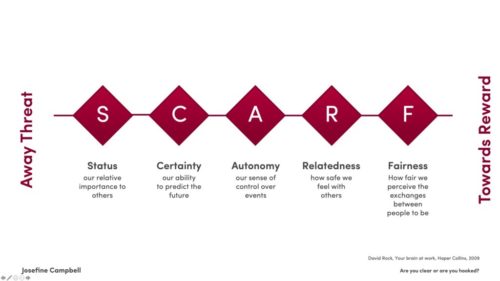
Share This Post
These days, there are many managers with anxiety, and as a leader you will most likely have to deal with anxiety in some way – yours or others. In my profession as an Executive Coach, I talk with highly competent and resourceful executives around the world about their challenges, problems, and objectives in life and in work. One question that is being discussed in many of my virtual coaching sessions these days is, how one is dealing with anxiety as a leader. My clients are executives in multinational corporations. Some of them are anxious. Actually, often they themselves are in a quite good position, but because they have a wider responsibility what used to be the normal pressure can become extra intense in times of crisis.
Being a manager with anxiety or dealing with anxiety as a leader can feel like a lonely affair. But actually you are not alone. Not at all.
Feeling anxious is very common
Anxiety is a normal feeling – unfortunately. The numbers for the UK is, that 8,9 million people in 2018 were under treatment for feeling anxious and the same picture shows in the Nordics. In Denmark, where I am based, 350.000 people are feeling anxious on a daily basis and 1 out of 10 will experience anxiety for some reason in life. But it’s not only in Denmark that anxiety is a common feeling. All over Europe we are feeling more anxious than ever before measured. Actually 12 % of the EU population are in treatment for anxiety.
One of the major reasons for anxiety is crises. A few years back the Brexit was a big player in increasing anxiety and stress for the EU citizens and of course mostly in the UK. This was a time (and still is) with huge uncertainty. All over Europe, therapists, coaches, psychologists etc. were seeing a jump in calls just after Brexit (and the following month over month) due to the uncertainty it raised. But, it is not only the major crises, that trigger our feeling of anxiety. Also, changes in life and organisational changes can be triggers. Because of the fact that anxiety, stress and depression are so common, and all three classified as widespread diseases, the European Union has made guidelines for companies and institutions facing organisational changes. To me, it shows that the EU takes it very seriously and recognize the unpleasant truth about how much anxiety, stress and depression are infecting our wellbeing.
Research points at, that especially big changes can cause anxiety, stress, and depression which infect the common wellbeing.
Would you like the newest knowledge and inspiration sent directly to you?
Then subscribe to our monthly newsletter
Uncertainty triggers your brain
As you can tell, uncertainty is a normal trigger in the brain for every human being. David Rock from the NeuroLeadership Institute has conceptualized the research, that scientists have made on what activates fear and stress in people. Certainty is a big trigger. It is just so, that not many people, especially not people in power, have the habit of exposing their anxiety. But that doesn’t mean, that they are not feeling it. On the contrary, a healthy person will sometimes feel anxiety.

3 ways to deal with uncertainty and anxiety
In the following, I will point out three approaches to deal with uncertainty and anxiety. Some of the approaches will feel easy, some will feel hard. It is not all quick fixes, but approaches that can make a substantial impact and improvement. Not just now, but for the rest of your life. Some ways might be more effective for some than others, so feel free to adjust and make them yours. Also, you might need to be able to combine some of the ways or add other ones. Every person is unique and that is one of the reasons why coaching is so effective, because in coaching we identify exactly what is provoking the anxiety in you, and what works for you as a leader dealing with the uncertainty and anxiety. So please consider the following to be more generic.
1. Take yourself out of the equation
One of my clients is the CIO of Carlsberg. Mark is a passionate leader, who really cares for his people (of course Mark has agreed on me using his name here). Hence, he can get easily engaged. One day I talked with Mark about how to stay agile when dealing with difficult problems, and he explained to me how he sometimes will think of and handle a problem. He takes himself out the equation, to be able to create the necessary distance to the problem to make the best decisions. It is a technique, that I as a coach call to detach. It is basically easier to deal with issues, that you don’t have a stake in. So, if it is something that you care a lot about, try to imagine that it is not you, but someone else’s problem you are dealing with and see what perspectives it will bring you. So, my question to you is now: “What would the situation look like, if you took yourself out of the equation?”.
2. Fueling your personal energy tank
Dealing with uncertainty, confronting anxiety, fear and making changes takes personal energy. If you want to make a checking on your personal energy level then, close your eyes and imaging that you have a barometer, that indicates how much personal energy you have. There is a scale from 0 -100, where 0 is nothing and 100 is full. What does it show? Is it enough to deal with difficult stuff that takes energy? If not, what can you do to fuel up your energy tank, if it isn’t full already? I am not talking about a quick fix from coffee or sugar, but something that substantially gives you more energy, such as a good night of sleep for more than just one day, long walks in nature, doing sports or whatever fills you up. What does fill you up?
In this video I talk a bit more about why I recommend you to fuel up your energy tank.
3. Dealing with the truth - you deal with uncertainty
One way dealing with anxiety as a leader, could be to escape mentally and to reject what is really going on. This can ease the discomfort for a second, but it will on longterm just increase your anxiety. Normal ways of escaping are: watching Netflix, drinking alkohol, or even just mentally escaping. Dealing with the truth can seem hard, but it can actually be more fulfilling than hiding. And it is not always as hard as it can seam before you do it. Once you face your fear, the object of your fear might not be as big as it felt, as when you were keeping it in the dark. My question to you is: “if you haven’t faced your fears already, what do you need to mobilize the courage to face the facts, and if you have a too hard time identifying what is your truth, who could you talk to, to get challenged on your perspectives?”.
I hope, that this article gave you some new insights to what you can do about it and hopefully how you can have an easier time, with you leading in times of uncertainty. But, if you’re experiencing more deeply anxiety with panic attacks, social discomfort etc. please contact your doctor for the right treatment.
I’ll gladly answer any questions, that you might have after reading this article – don’t hesitate to call or sent me an e-mail. You can also request to book a session with me by clicking on the button at the end of this post. Normally I offer to have a chat with people in person or online before we plan a real session.
The best of luck and take care! And remember that all we do, we do with the vision that people don’t just have to perform. But by unlocking the power of personal energy in all organizations we can create long-term value in a sustainable way.
If you would like to be updated with new articles and videos, sign up for our mailing list. Your mail is not shared with anyone and there are advantages to being on the list e.g., getting a mini course in your personal leadership.












